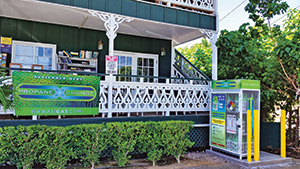Retailer differentiating exchange program on islands with composites
Hawaii Gas is by far the largest propane retailer in Hawaii and the most dominant provider in the state. But the company’s sheer size doesn’t necessarily shield it from oncoming competition.
Hawaii’s cylinder-fill market, for example, has undergone change in the last few years, according to Cheryl Lien-Fua, an operations superintendent at Hawaii Gas. Cylinder fill is also an area where Hawaii Gas has made some recent adjustments.
“We’re not a big exchange market yet,” Lien-Fua says of Hawaii. “Trends always get here last. People still fill their own [cylinders] here, but we’re seeing that volume erode as the big boxes come in. They had national contracts with retailers, and we started to see people swapping out for exchange service. So we decided we better look into that market.”
Hawaii Gas went the composite cylinder route in 2012, preferring to provide an alternative to steel and a product that offered some unique benefits. But Hawaii Gas’ initial vendor was The Lite Cylinder Co., whose composites were recalled midway through 2013.
Hawaii Gas had established a few composite cylinder exchange locations by that time. The recall forced Hawaii Gas to restrategize.
Ultimately, Hawaii Gas partnered with Hexagon Ragasco, a Norwegian company whose brand, Viking Cylinders, is making headway in North America. The transition from one vendor to the other was seamless, Lien-Fua says.
“We issued the recall, picked everything up out of the cages, offered a refund and a rebate – a free exchange,” says Lien-Fua, who manages Hawaii Gas’ cylinder exchange program called PropaneXchange.
Now, Lien-Fua says, Hawaii Gas has almost 6,000 composites in the field. The company has exchange sites on two of Hawaii’s main islands, she adds, and its goal is to be on five main islands by the end of this year.
“We ran the program on Oahu and Kauai to see if it was going to be accepted,” says Lien-Fua, whose composites have lime green tops. “Kauai is the island that gets demolished from hurricanes. They’re heavy in propane because they know they can always count on gas when electricity goes down.”
Composites are a good fit for Hawaii, Lien-Fua adds, because the ocean air doesn’t affect their surface like it does steel cylinders.
“We are by the ocean, so there is more propensity to rust and degrade over time,” she says. “We do see a lot of quick deterioration with the salt water and salt air on [steel]. We’re looking at the composites to last a little longer and maintain their sightliness.”
Lien-Fua is finding that the composites have other benefits, too.
“They’re stackable,” she says. “For women and senior citizens who do exchanges, they’re something different to offer them. Some people are willing to pay for that convenience. Plus, there’s the fact that you can see your propane level.”
COMPANY: Hawaii Gas
LOCATION: Honolulu
FOUNDED: 1904
EMPLOYEES: 300
CUSTOMERS: 68,000
PROPANE SALES: 46 million annual gallons
ONLINE: www.hawaiigas.com
Photo: Hawaii Gas

















